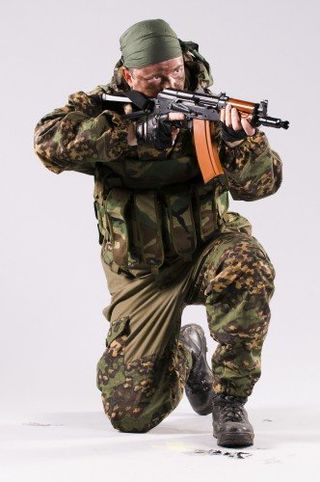How the world’s most-realistic military game gets made
PCG: To some extent, Bohemia has been refining the game that it makes since the original Operation Flashpoint in 2001. You're working on Carrier Command now, too, but simulation is the core of your business. Do you feel happy with the niche you've carved out for yourself in the gaming community? As a developer, are you "creating the game you want to play," or something else?
Spanel: In the good old days, we were creating the game mostly for ourselves, plus for about 50 active community members on our forums back in 1999. It is definitely a very viable niche that we have, and we are still really committed to it. On the other hand, we also are interested in attracting “new blood” or exploring completely new areas. Our studio has grown and many great local talents, with experience in various genres (RTS, adventure or RPG) have joined our team.
We are trying to build completely new things alongside our core business. A 10-year legacy is an incredible achievement; yet, conversely, it is also a weight upon our shoulders. For example, changing some fundamental technical aspect or gameplay feature, which may appear simple, actually becomes a huge task when implemented within the context of ten years of previous work.

PCG: Being the developer of both VBS and ArmA 2, how does Bohemia's structure and development schedule differ from most developers?
Spanel: Bohemia Interactive has dedicated studios that focus upon each part of the business and both run nearly independently (but benefiting very much from each other). The games development part is probably quite similar to other medium-sized independent developers; yet, the simulation industry is very different. It's much more client-facing, involving smaller cycles and firmer deadlines; whereas, the games side of the business is more creative, and is based upon what we want to achieve, and where we want to take our product. Our gaming side is around 75 people at the moment.
PC Gamer Newsletter
Sign up to get the best content of the week, and great gaming deals, as picked by the editors.
The core team of ArmA 2 developers now consists of approximately 40 people, the rest work on other projects or are involved purely in publishing, PR, or distribution, as Bohemia Interactive is, more and more, taking on the mantle of a publisher.

PCG: What's the scene like around the office at Bohemia?
Spanel: Bohemia Interactive has offices in multiple locations: two in Prague and another in Brno. The HQ of Bohemia is located in beautiful countryside, with the forest starting just behind the company grounds. We have a calm area, with a nice small pond, far from rush of modern life and busy cities. Our sister company, dedicated to military simulations, has offices in Australia, the Czech Republic and USA.
PCG: Speaking of the Czech Republic, ArmA 2's main map, Chernarus, is a fascimile of your native land. What's it like to drive a tank through your own backyard?
Spanel: Seeing the real landscape abstracted in a virtual environment has always been a very fascinating aspect of our games. Even our first game, Operation Flashpoint, was very closely based upon real islands, combined with objects from our country.
Chernarus, the country from ArmA 2, went even further and is very close to a real chunk of our country. When it comes to driving tanks there, it just feels super-authentic. Turning this landscape into a game terrain is a tribute to this little piece of the Czech Republic. When we developed ArmA 2, the knowledge of the landscape helped us a lot in finding the locations for the scenarios and it is also really interesting visiting this place again in reality after spending so many hours there in game. For reference: search for “Povrly” in Google Maps to find the real location.

PCG: There's a temptation to think that Bohemia is made up of many former military or contractors. Is that the case?
Spanel: Not a huge number number, no. Rather, we always strive to get advice and evaluation of our projects from our "military advisors"--either men in active service or retired soldiers, and often from our gaming community, who are happy to share their know-how. Most of the team are civilians with a passion for the military setting and simulations in general; however, the team behind the simulations aspect of our business is different in this regard, with more former military staff.

Evan's a hardcore FPS enthusiast who joined PC Gamer in 2008. After an era spent publishing reviews, news, and cover features, he now oversees editorial operations for PC Gamer worldwide, including setting policy, training, and editing stories written by the wider team. His most-played FPSes are CS:GO, Team Fortress 2, Team Fortress Classic, Rainbow Six Siege, and Arma 2. His first multiplayer FPS was Quake 2, played on serial LAN in his uncle's basement, the ideal conditions for instilling a lifelong fondness for fragging. Evan also leads production of the PC Gaming Show, the annual E3 showcase event dedicated to PC gaming.
Most Popular

